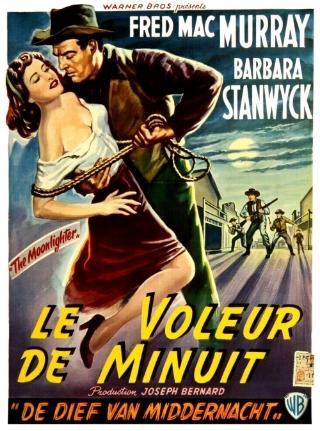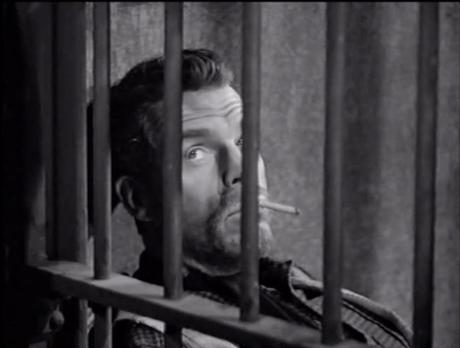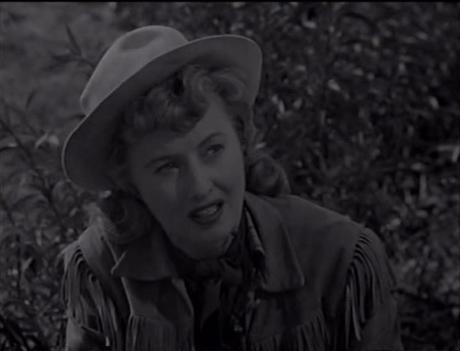
Over a sixteen year period, starting in 1940 and ending in 1956, Fred MacMurray and Barbara Stanwyck made four movies together, the most famous probably being Billy Wilder’s Double Indemnity. Their third collaboration, The Moonlighter (1953), was the only western and the least familiar of the titles. This is a film I’ve only recently caught up with, once again thanks to the assistance of regular contributor Jerry Entract, and I found it a slightly unfocused but generally enjoyable affair. Revenge and redemption, those two faithful old partners in so many westerns, dominate but one is only half explored before being quietly dropped while the other is slipped in as though an afterthought. My feeling is that if these two themes had been more fully, or at least more consistently, developed, then The Moonlighter would have been a much stronger piece of work.
Wes Anderson (Fred MacMurray) is the moonlighter of the title, a rustler who operates by night, and his opening narration places the action at the beginning of the 20th century, just as the frontier is about to finally close. As he tells us, civilization about to consign the myth of the wild west to the pages of history, but the beast’s claws haven’t been filed down totally yet. The concept of frontier justice still holds sway with some, and the crime of rustling continues to arouse strong feelings and attract harsh punishments. As Anderson sits in jail awaiting trial, a lynching party is arriving in town, impatient and aggressive. This first act of the film is the most powerful, soulful and threatening, and setting up a situation packed with potential. There’s an almost noirish, and indeed nightmarish, tone as the mob forces its way into the jail to demand its pound of flesh. There’s to be no heroic last-minute rescue as a man is mercilessly beaten, dragged from his cell, and hanged without ceremony. Only it’s the wrong man, the fates having conspired to save a guilty man while simultaneously dooming an innocent one. Anderson has been handed a new lease on life but with a bitter little proviso attached – his sense of guilt twisting itself into a thirst for revenge. However, it’s at this point, with the story part of the way down an intriguing avenue, that the focus of the script shifts and revenge drifts away to be replaced by, amongst other things, greed. With Anderson forced to rest up and recuperate in his old family home, other characters are added into the mix: Rela (Barbara Stanwyck), his former love is introduced along with his brother Tom (William Ching). This creates the possibility of a romantic triangle although it doesn’t really work out that way. Instead we meet Cole Gardner (Ward Bond), an old outlaw associate of Wes’ who is keen to talk him into going back into business. I won’t spoil the plot by revealing more about how it all pans out except to say that Wes gets to earn his redemption the hard way, suffering significant personal losses before regaining his sense of honor in the end.

The Moonlighter was written by Niven Busch, a man known for his fondness for grand passions and dark psychology. The film hints at this, or perhaps flirts with it, both in the terrific opening and later in the relationship between Wes and Rela. Yet it doesn’t come off successfully; there’s none of the high melodrama of Duel in the Sun or The Furies, nor enough of the darkness of Pursued. Now I like Busch’s work, although I understand if it’s not to everyone’s taste, and the way it has of burrowing into the minds and motivations of characters. The main problem with The Moonlighter is that it never goes far enough, all the ingredients are present and paths are started on but abandoned or strayed from before the themes have a chance to breathe and expand. Then when the redemptive aspect kicks in at the end it feels rushed and loses some of its impact as a consequence.
The director was Roy Rowland, examples of whose work I’ve looked at here in the past, and his handling of the material is patchy too. Again, I refer back to the opening, where he and cinematographer Bert Glennon hit just the right chord and conjure up an atmosphere that’s menacing and quite poignant. But his direction lacks consistency, and as soon as the action moves to the Anderson homestead there’s a flatness that reflects the loss of momentum in the script. The scene where MacMurray and Stanwyck meet after years apart only touches on their shared passion, the actors doing what they can with the dialogue, but it needs a spark and intensity that’s not achieved. Some of that does come as the story progresses, but I don’t feel it ever reaches the heights necessary to make the redemptive payoff work as well as it should.

MacMurray often made a fine anti-hero or villain, in this case I’d say he was playing the former though. When required he could tap into a kind of weary cynicism, and that’s exactly how he starts out – we first encounter him lazing in his jail cell awaiting what he fully expects to be an appointment with the hangman. The weariness falls away later, anger, distrust and bitterness coming along to displace it and MacMurray keeps it credible all the time. He also hangs onto a touch of decency too, despite his character’s criminal nature, which is vital if his eventual change of heart is to be at all convincing. Stanwyck was playing one of her signature tough broads and she’s perfectly satisfactory, as usual, though the role doesn’t have the kind of depth or shading which could bring out the best in her. She’s said to have enjoyed making westerns and the rugged outdoors stuff attracted her, something she got to indulge in here especially during the well filmed climax. Ward Bond doesn’t make an appearance until around the halfway mark, but impresses as the unscrupulous outlaw seeking out a partner to facilitate his schemes. Bond was typically most effective as bluff down-to-earth types or as an imposing physical threat. The movie gives him the chance to show off both of these aspects, moving smoothly from one to the other as the plot advances. Personally, I found William Ching the weakest link – his part is an important one yet he never really convinced me as the brother living in MacMurray’s shadow. In support, there are nice, if short-lived, turns by the likes of John Dierkes, Jack Elam, Charles Halton and Morris Ankrum.
The Moonlighter has been released as an MOD DVD in the US as part of the Warner Archive and is certainly worth a look. The turn of the century setting is potentially interesting but not a lot is made of this – the only real reference to the changing times is that Bond’s plan involves exploiting the possibilities afforded by the new motor cars. The movie was shot in 3D but I don’t know if that would add much to it (I’m no particular fan of the process myself) and it plays fine in standard 2D. Taken as a whole, the film is entertaining enough although it did need a script which retained a stronger focus and more character analysis. It starts off well and does have its moments later but meanders a little despite the short running time.
